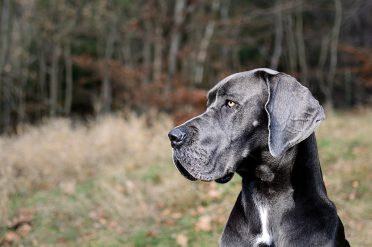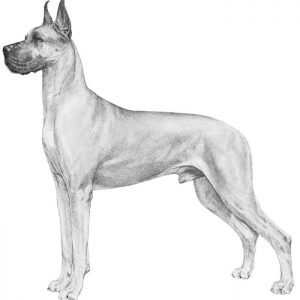This page contains affiliate links. We may earn money or products from the companies mentioned in this post through our independently chosen links, which earn us a commission. Learn More
 The Great Dane is a dog breed that originated from Germany, and it’s mostly known because of its size, it’s the biggest dog breed. The size of the Great Dane is about 28 to 36 inches tall, weighing between 99 to 200 pounds. The lifespan of the Great Dane is around 8 to 10 years.
The Great Dane is a dog breed that originated from Germany, and it’s mostly known because of its size, it’s the biggest dog breed. The size of the Great Dane is about 28 to 36 inches tall, weighing between 99 to 200 pounds. The lifespan of the Great Dane is around 8 to 10 years.
Great Danes are one of the sweetest, most loveable dogs in the world.
However, as great a friend as they might be, they still require a certain amount of care that will mould them into calm, kind, and even playful companions. For those of you who aren’t Great Dane experts just yet, take a look at some facts and simple instructions for caring for this dog.
Contents & Quick Navigation
1. Living with a big dog
Contrary to popular belief the Great Dane, though intimidatingly large, is only the second largest breed of dog, the first being the English Mastiff. The reason for the Great Dane’s striking size is due to its origins. In the 17th Century, a speedy and light-footed dog was bred, thus came the Great Dane.
As mentioned above the Great Danes can grow up to 3 feet tall and weigh 99 to 200 pounds. While it isn’t completely necessary to have a house and a yard to accommodate these large dogs, it’s still important that they have enough space in which to roam around. This means taking them on regular walks or playing with them in your neighborhood park.
The total bill comes a bit pricey as they need higher quantities and volumes of supplies such as food and medication as well as larger beds, crates, and toys.
A sample breakdown: expect to spend $15 per week on food.
2. Training
 A common misconception of Great Danes is that they’re aggressive. The truth is that any breed of dog can be aggressive unless trained at an early age to be otherwise. Early training can also benefit their social behavior with other dogs, animals, and even humans.
A common misconception of Great Danes is that they’re aggressive. The truth is that any breed of dog can be aggressive unless trained at an early age to be otherwise. Early training can also benefit their social behavior with other dogs, animals, and even humans.
This type of training is what leads most Great Danes into becoming “Gentle Giants”. While it’s important to train Great Dane puppies, in particular, it’s also just as important that they are trained properly.
Like almost every other dog Great Danes respond better and faster to positive reinforcement and clear commands than any other method.
Active tasks are allowed, but not too much. Great Danes, like all large dogs, are prone to bone and joint problems if they’re exercised too frequently. Maintain a strict schedule of one long walk per day for adult-sized Great Danes. Other approved activities are fetching and swimming.
Canine freestyle is another activity that gives your Great Dane the exercise he needs without straining his joints.
Great Danes are also prone to bloating. To prevent this, wait at least an hour after you have fed your Great Dane before you play with them.
3. Low Maintenance
Since Great Danes are short-haired, they do shed, but this can be controlled by daily brushing. It’s best to either use a brush with bristles or a rubber curry one.
Severe hair loss is a sign of a low functioning thyroid. If you see too much hair on your floor, it’s recommended that you speak with your veterinarian.
Consistent brushing can also reduce the number of baths you give your dog, though Great Danes are known to go crazy with joy over bathtime. The only issue that may arise is the space in which your Great Dane is bathing. Small spaces can cause Great Danes discomfort, so avoid bathtubs and give them a mini pool.
Both their ears and their teeth should be thoroughly cleaned at least once every two weeks. While the mouth may be easy to clean due to its size, for this same reason, Great Danes have a tendency to drool, so make sure you bring a drool rag for extra demanding activities.
Nails that are too long can cause paw injuries to a Great Dane, so trimming must be done every couple of weeks.
4. When You’re Away
Yet another misconception of Great Danes is that they make great guard dogs. This is mostly because of their stance and dimensions which scares the hell out of most strangers.
While any dog can be trained to protect, Great Danes are actually very sweet to any person or creature. In fact, they are so attached to people, specifically their owners, that they are often troubled with separation anxiety.
A simple trick to appease this is to acquire a crate for the dog to stay in while you’re away. It should be clarified that crates are not to be used for punishment, but should be like a second home for your Great Dane. It should contain toys, a bed, and maybe some food to keep your dog calm during those stressful and lonely times.
5. They’re People Dogs
Great Danes were meant for homes for the sole reason to be with humans. They’re incredibly loyal, and dependant on the interaction between them and their owners.
They’re also good with kids as they’re playful and protective, as well as tolerant with smaller children who like to tug at their ears and tails. Don’t be discouraged to invest in a Great Dane. Most owners find them to be sweet and cuddly.
Some Great Dane Mixes
The Canis Panther Is Four Great Dogs In One
Meet Your Gentle Giant, the Labradane (AKA the Great Dane and Lab Mix)
Conclusion
I’ve always been interested in larger dogs. They just have the personality that’s so similar to that of a human’s. Unfortunately, owners need to allot the time, money, and space for such companionship, and Great Danes are no exception.
Great Danes need to be with people who allow them to play in the backyard or at the closest park. So if you have a large home or children interested in having a pet, then a Great Dane may be perfect for you.
If you like what you see here about the Great Dane, but are still researching, I suggest that you check out other giant dogs.

Leave a Reply